MOD003507 Principles of Marketing: Tesla's Marketing Strategy Report
VerifiedAdded on 2024/01/17
|7
|1763
|200
Report
AI Summary
This report provides a formal analysis of Tesla Motors' promotional mix, applying push and pull strategies alongside above-the-line (ATL) and below-the-line (BTL) marketing theories. It critiques the implementation of these strategies over the past two years, assessing their effectiveness through key performance indicators. Tesla's minimal investment in BTL advertising, absence of a chief marketing officer, and reliance on ATL techniques are highlighted. The significant role of CEO Elon Musk in leveraging social media to attract followers and generate buzz is also discussed. The report further emphasizes Tesla's customer service and the expansion of supercharging stations as effective pull strategies, contributing to increased sales figures. Ultimately, the analysis concludes that Tesla's ATL and pull strategies have been instrumental in attracting and retaining customers, enhancing brand image, and driving sales growth.
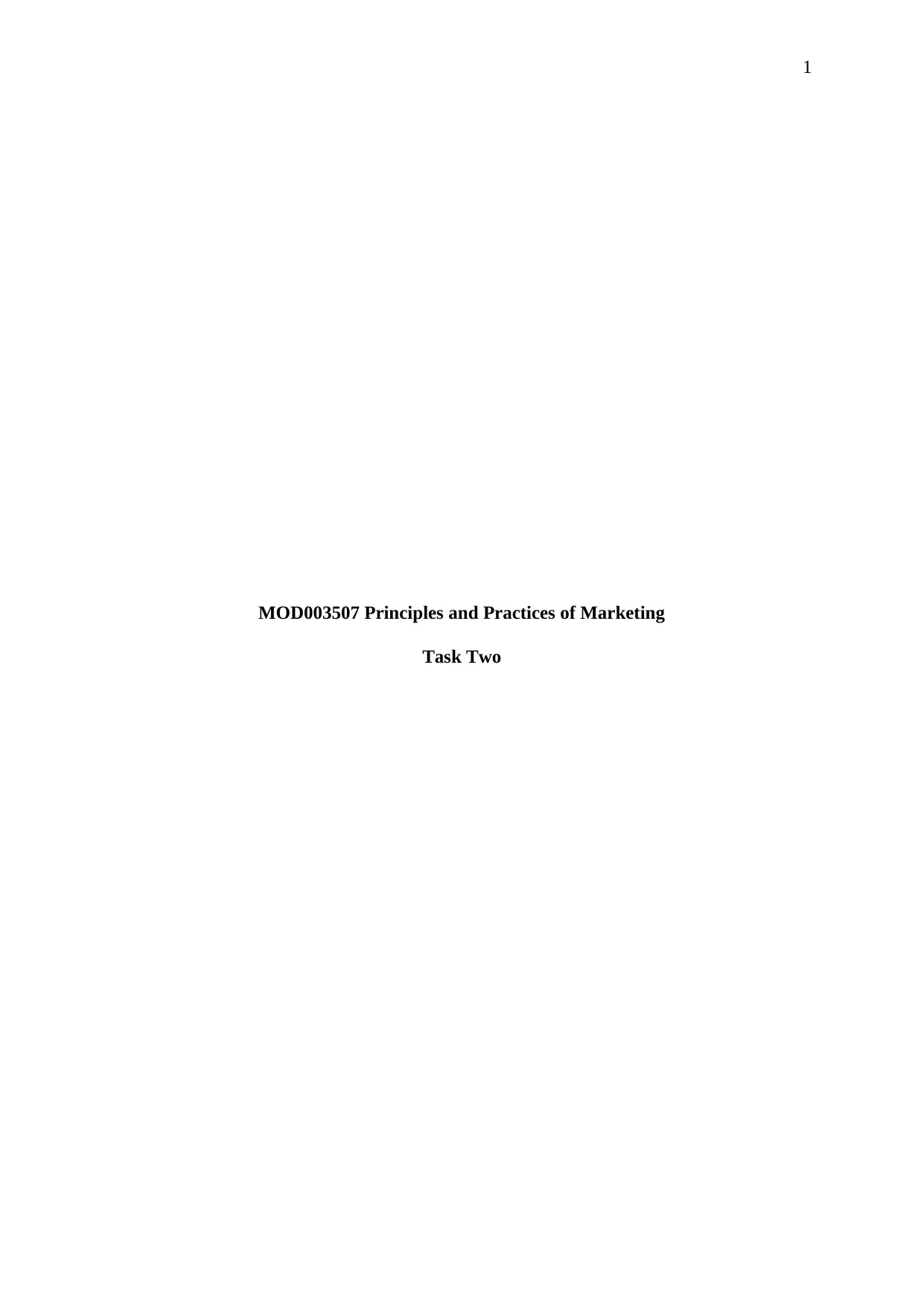
1
MOD003507 Principles and Practices of Marketing
Task Two
MOD003507 Principles and Practices of Marketing
Task Two
Paraphrase This Document
Need a fresh take? Get an instant paraphrase of this document with our AI Paraphraser
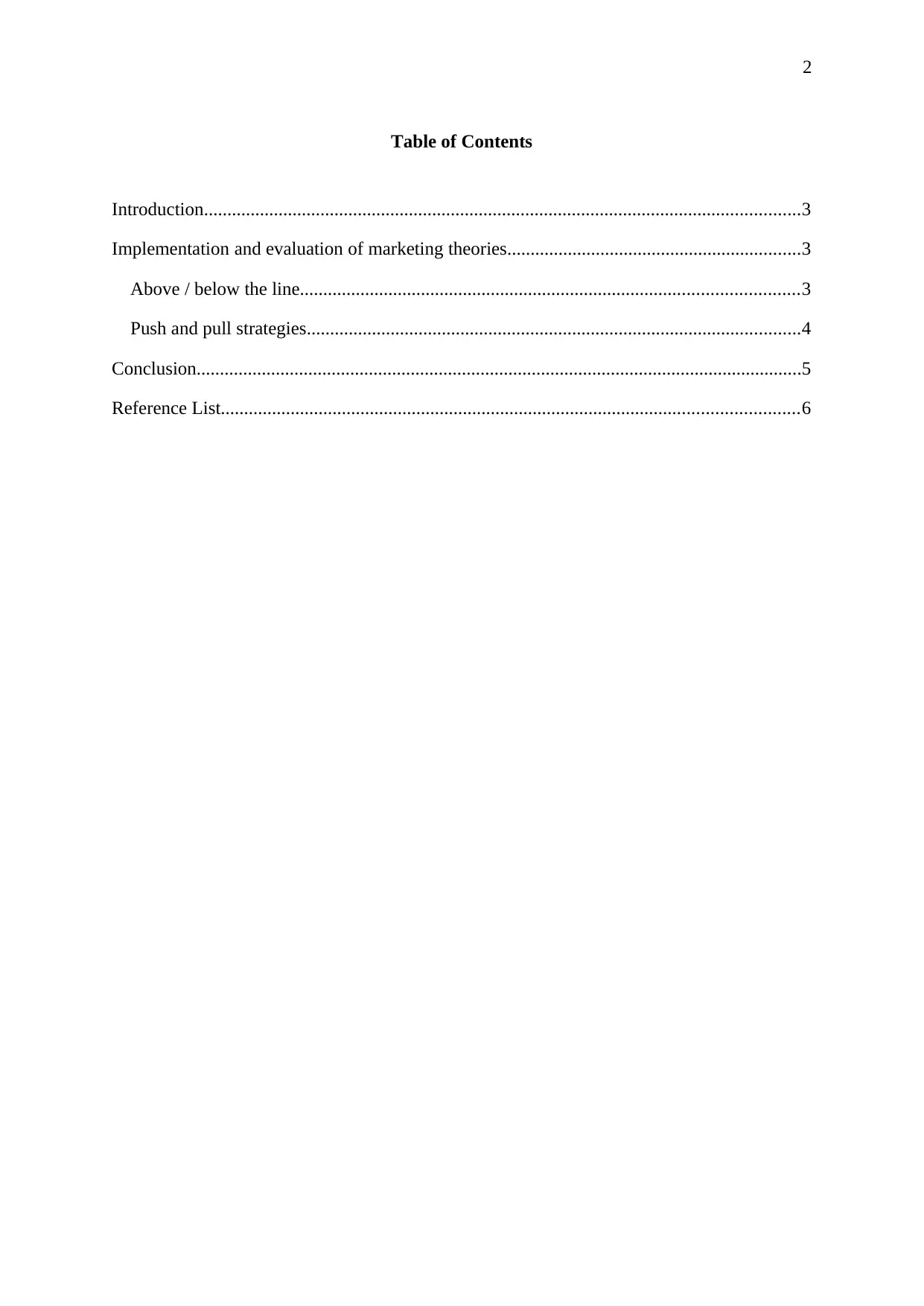
2
Table of Contents
Introduction................................................................................................................................3
Implementation and evaluation of marketing theories...............................................................3
Above / below the line...........................................................................................................3
Push and pull strategies..........................................................................................................4
Conclusion..................................................................................................................................5
Reference List............................................................................................................................6
Table of Contents
Introduction................................................................................................................................3
Implementation and evaluation of marketing theories...............................................................3
Above / below the line...........................................................................................................3
Push and pull strategies..........................................................................................................4
Conclusion..................................................................................................................................5
Reference List............................................................................................................................6
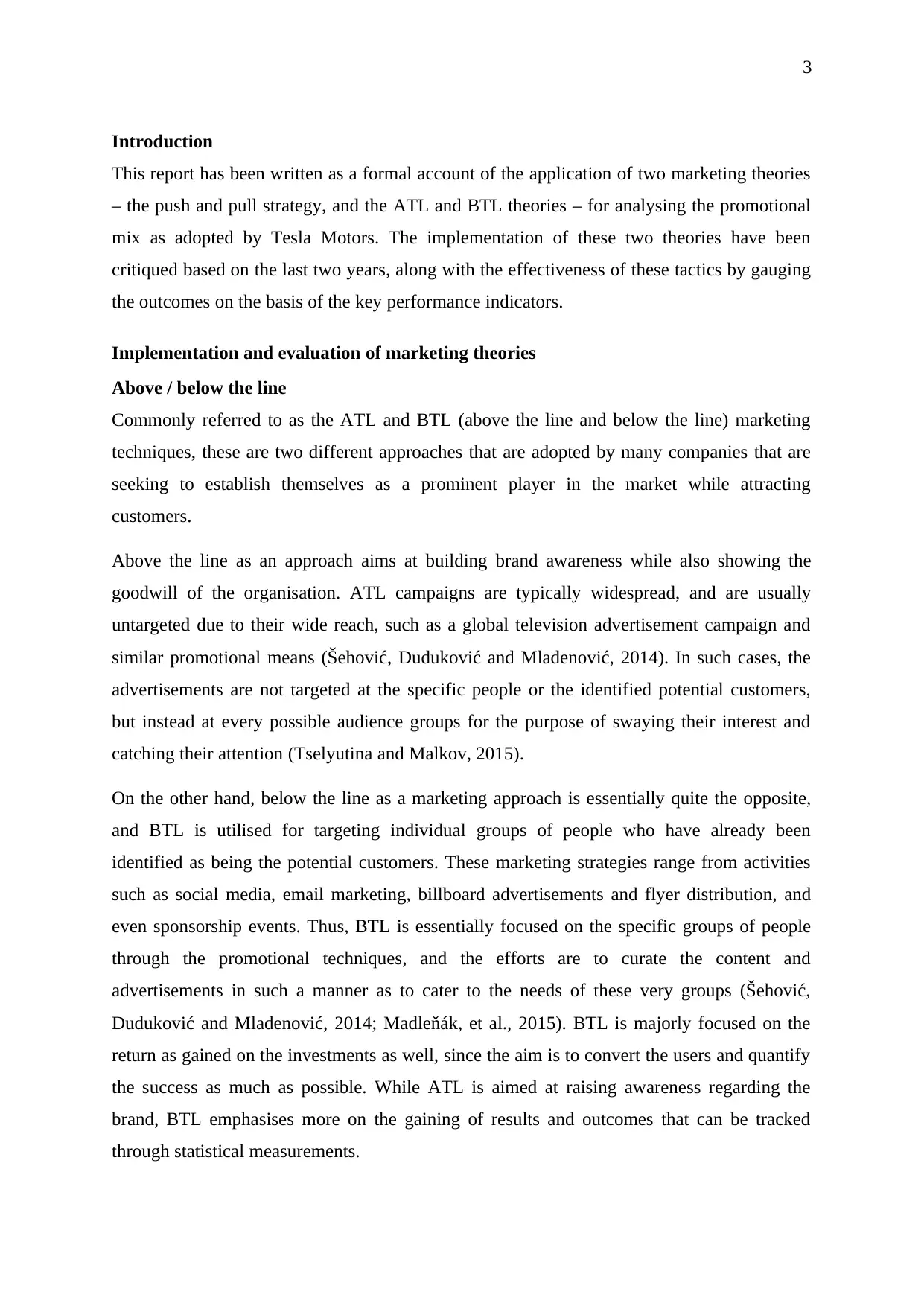
3
Introduction
This report has been written as a formal account of the application of two marketing theories
– the push and pull strategy, and the ATL and BTL theories – for analysing the promotional
mix as adopted by Tesla Motors. The implementation of these two theories have been
critiqued based on the last two years, along with the effectiveness of these tactics by gauging
the outcomes on the basis of the key performance indicators.
Implementation and evaluation of marketing theories
Above / below the line
Commonly referred to as the ATL and BTL (above the line and below the line) marketing
techniques, these are two different approaches that are adopted by many companies that are
seeking to establish themselves as a prominent player in the market while attracting
customers.
Above the line as an approach aims at building brand awareness while also showing the
goodwill of the organisation. ATL campaigns are typically widespread, and are usually
untargeted due to their wide reach, such as a global television advertisement campaign and
similar promotional means (Šehović, Duduković and Mladenović, 2014). In such cases, the
advertisements are not targeted at the specific people or the identified potential customers,
but instead at every possible audience groups for the purpose of swaying their interest and
catching their attention (Tselyutina and Malkov, 2015).
On the other hand, below the line as a marketing approach is essentially quite the opposite,
and BTL is utilised for targeting individual groups of people who have already been
identified as being the potential customers. These marketing strategies range from activities
such as social media, email marketing, billboard advertisements and flyer distribution, and
even sponsorship events. Thus, BTL is essentially focused on the specific groups of people
through the promotional techniques, and the efforts are to curate the content and
advertisements in such a manner as to cater to the needs of these very groups (Šehović,
Duduković and Mladenović, 2014; Madleňák, et al., 2015). BTL is majorly focused on the
return as gained on the investments as well, since the aim is to convert the users and quantify
the success as much as possible. While ATL is aimed at raising awareness regarding the
brand, BTL emphasises more on the gaining of results and outcomes that can be tracked
through statistical measurements.
Introduction
This report has been written as a formal account of the application of two marketing theories
– the push and pull strategy, and the ATL and BTL theories – for analysing the promotional
mix as adopted by Tesla Motors. The implementation of these two theories have been
critiqued based on the last two years, along with the effectiveness of these tactics by gauging
the outcomes on the basis of the key performance indicators.
Implementation and evaluation of marketing theories
Above / below the line
Commonly referred to as the ATL and BTL (above the line and below the line) marketing
techniques, these are two different approaches that are adopted by many companies that are
seeking to establish themselves as a prominent player in the market while attracting
customers.
Above the line as an approach aims at building brand awareness while also showing the
goodwill of the organisation. ATL campaigns are typically widespread, and are usually
untargeted due to their wide reach, such as a global television advertisement campaign and
similar promotional means (Šehović, Duduković and Mladenović, 2014). In such cases, the
advertisements are not targeted at the specific people or the identified potential customers,
but instead at every possible audience groups for the purpose of swaying their interest and
catching their attention (Tselyutina and Malkov, 2015).
On the other hand, below the line as a marketing approach is essentially quite the opposite,
and BTL is utilised for targeting individual groups of people who have already been
identified as being the potential customers. These marketing strategies range from activities
such as social media, email marketing, billboard advertisements and flyer distribution, and
even sponsorship events. Thus, BTL is essentially focused on the specific groups of people
through the promotional techniques, and the efforts are to curate the content and
advertisements in such a manner as to cater to the needs of these very groups (Šehović,
Duduković and Mladenović, 2014; Madleňák, et al., 2015). BTL is majorly focused on the
return as gained on the investments as well, since the aim is to convert the users and quantify
the success as much as possible. While ATL is aimed at raising awareness regarding the
brand, BTL emphasises more on the gaining of results and outcomes that can be tracked
through statistical measurements.
⊘ This is a preview!⊘
Do you want full access?
Subscribe today to unlock all pages.

Trusted by 1+ million students worldwide
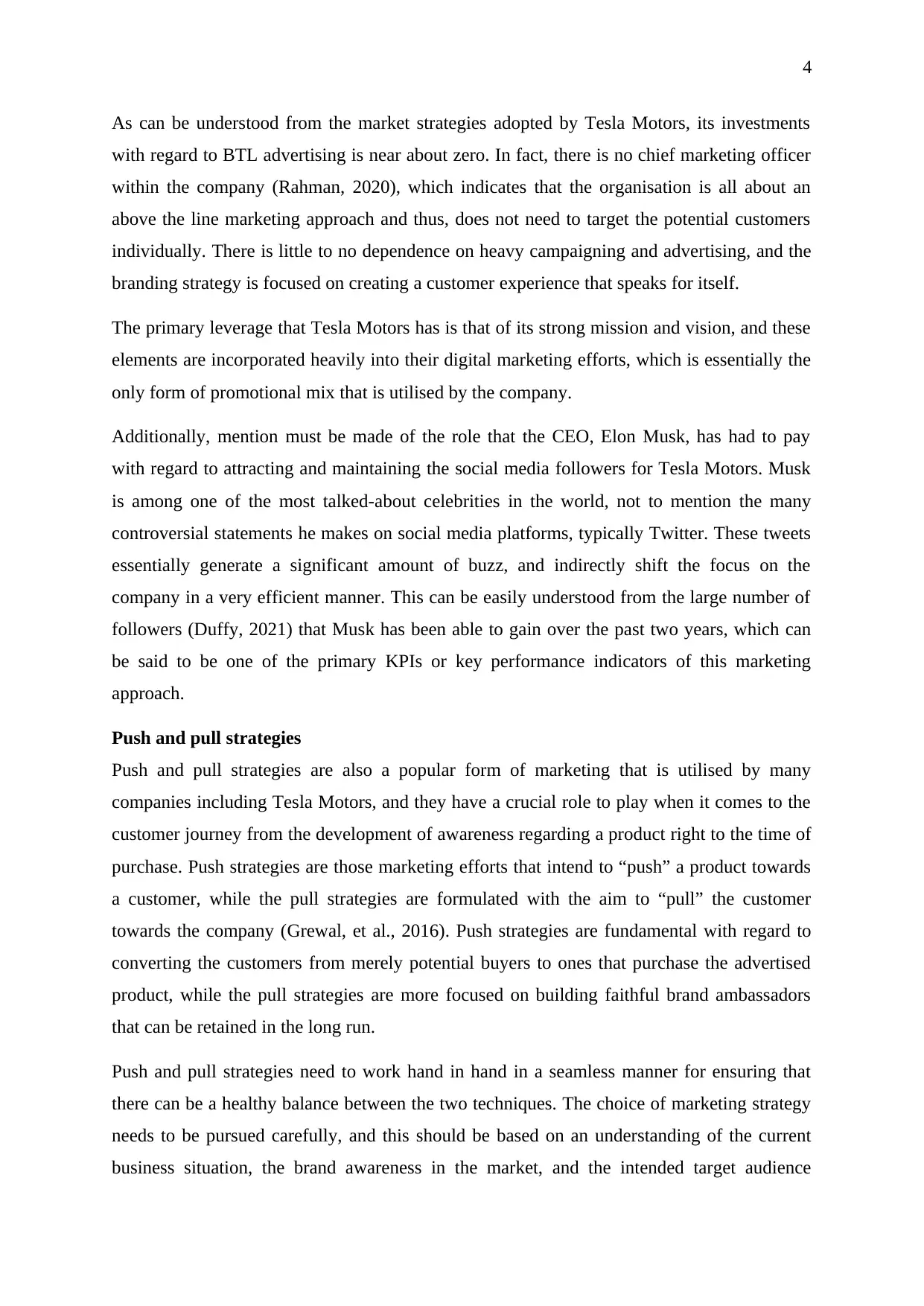
4
As can be understood from the market strategies adopted by Tesla Motors, its investments
with regard to BTL advertising is near about zero. In fact, there is no chief marketing officer
within the company (Rahman, 2020), which indicates that the organisation is all about an
above the line marketing approach and thus, does not need to target the potential customers
individually. There is little to no dependence on heavy campaigning and advertising, and the
branding strategy is focused on creating a customer experience that speaks for itself.
The primary leverage that Tesla Motors has is that of its strong mission and vision, and these
elements are incorporated heavily into their digital marketing efforts, which is essentially the
only form of promotional mix that is utilised by the company.
Additionally, mention must be made of the role that the CEO, Elon Musk, has had to pay
with regard to attracting and maintaining the social media followers for Tesla Motors. Musk
is among one of the most talked-about celebrities in the world, not to mention the many
controversial statements he makes on social media platforms, typically Twitter. These tweets
essentially generate a significant amount of buzz, and indirectly shift the focus on the
company in a very efficient manner. This can be easily understood from the large number of
followers (Duffy, 2021) that Musk has been able to gain over the past two years, which can
be said to be one of the primary KPIs or key performance indicators of this marketing
approach.
Push and pull strategies
Push and pull strategies are also a popular form of marketing that is utilised by many
companies including Tesla Motors, and they have a crucial role to play when it comes to the
customer journey from the development of awareness regarding a product right to the time of
purchase. Push strategies are those marketing efforts that intend to “push” a product towards
a customer, while the pull strategies are formulated with the aim to “pull” the customer
towards the company (Grewal, et al., 2016). Push strategies are fundamental with regard to
converting the customers from merely potential buyers to ones that purchase the advertised
product, while the pull strategies are more focused on building faithful brand ambassadors
that can be retained in the long run.
Push and pull strategies need to work hand in hand in a seamless manner for ensuring that
there can be a healthy balance between the two techniques. The choice of marketing strategy
needs to be pursued carefully, and this should be based on an understanding of the current
business situation, the brand awareness in the market, and the intended target audience
As can be understood from the market strategies adopted by Tesla Motors, its investments
with regard to BTL advertising is near about zero. In fact, there is no chief marketing officer
within the company (Rahman, 2020), which indicates that the organisation is all about an
above the line marketing approach and thus, does not need to target the potential customers
individually. There is little to no dependence on heavy campaigning and advertising, and the
branding strategy is focused on creating a customer experience that speaks for itself.
The primary leverage that Tesla Motors has is that of its strong mission and vision, and these
elements are incorporated heavily into their digital marketing efforts, which is essentially the
only form of promotional mix that is utilised by the company.
Additionally, mention must be made of the role that the CEO, Elon Musk, has had to pay
with regard to attracting and maintaining the social media followers for Tesla Motors. Musk
is among one of the most talked-about celebrities in the world, not to mention the many
controversial statements he makes on social media platforms, typically Twitter. These tweets
essentially generate a significant amount of buzz, and indirectly shift the focus on the
company in a very efficient manner. This can be easily understood from the large number of
followers (Duffy, 2021) that Musk has been able to gain over the past two years, which can
be said to be one of the primary KPIs or key performance indicators of this marketing
approach.
Push and pull strategies
Push and pull strategies are also a popular form of marketing that is utilised by many
companies including Tesla Motors, and they have a crucial role to play when it comes to the
customer journey from the development of awareness regarding a product right to the time of
purchase. Push strategies are those marketing efforts that intend to “push” a product towards
a customer, while the pull strategies are formulated with the aim to “pull” the customer
towards the company (Grewal, et al., 2016). Push strategies are fundamental with regard to
converting the customers from merely potential buyers to ones that purchase the advertised
product, while the pull strategies are more focused on building faithful brand ambassadors
that can be retained in the long run.
Push and pull strategies need to work hand in hand in a seamless manner for ensuring that
there can be a healthy balance between the two techniques. The choice of marketing strategy
needs to be pursued carefully, and this should be based on an understanding of the current
business situation, the brand awareness in the market, and the intended target audience
Paraphrase This Document
Need a fresh take? Get an instant paraphrase of this document with our AI Paraphraser
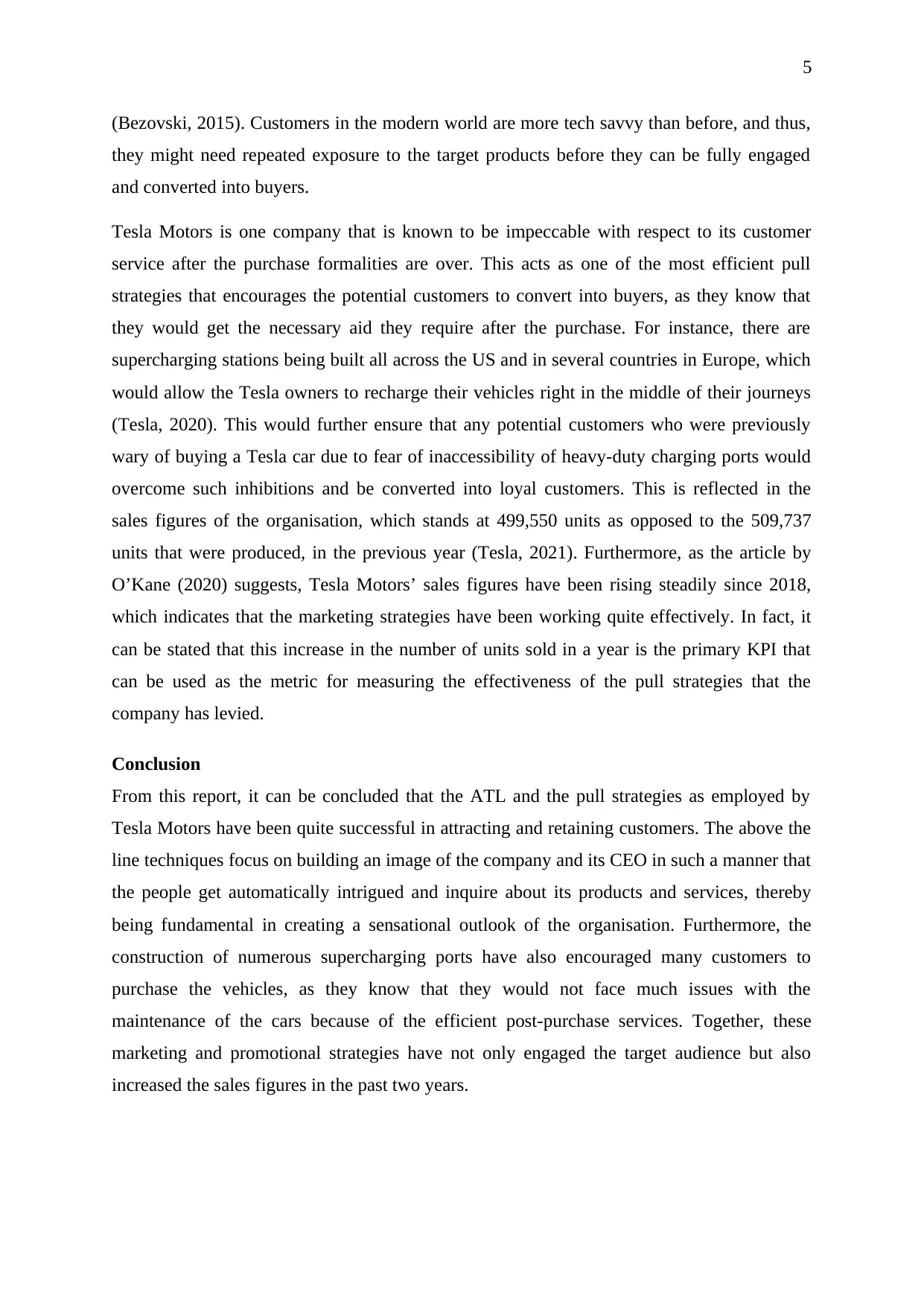
5
(Bezovski, 2015). Customers in the modern world are more tech savvy than before, and thus,
they might need repeated exposure to the target products before they can be fully engaged
and converted into buyers.
Tesla Motors is one company that is known to be impeccable with respect to its customer
service after the purchase formalities are over. This acts as one of the most efficient pull
strategies that encourages the potential customers to convert into buyers, as they know that
they would get the necessary aid they require after the purchase. For instance, there are
supercharging stations being built all across the US and in several countries in Europe, which
would allow the Tesla owners to recharge their vehicles right in the middle of their journeys
(Tesla, 2020). This would further ensure that any potential customers who were previously
wary of buying a Tesla car due to fear of inaccessibility of heavy-duty charging ports would
overcome such inhibitions and be converted into loyal customers. This is reflected in the
sales figures of the organisation, which stands at 499,550 units as opposed to the 509,737
units that were produced, in the previous year (Tesla, 2021). Furthermore, as the article by
O’Kane (2020) suggests, Tesla Motors’ sales figures have been rising steadily since 2018,
which indicates that the marketing strategies have been working quite effectively. In fact, it
can be stated that this increase in the number of units sold in a year is the primary KPI that
can be used as the metric for measuring the effectiveness of the pull strategies that the
company has levied.
Conclusion
From this report, it can be concluded that the ATL and the pull strategies as employed by
Tesla Motors have been quite successful in attracting and retaining customers. The above the
line techniques focus on building an image of the company and its CEO in such a manner that
the people get automatically intrigued and inquire about its products and services, thereby
being fundamental in creating a sensational outlook of the organisation. Furthermore, the
construction of numerous supercharging ports have also encouraged many customers to
purchase the vehicles, as they know that they would not face much issues with the
maintenance of the cars because of the efficient post-purchase services. Together, these
marketing and promotional strategies have not only engaged the target audience but also
increased the sales figures in the past two years.
(Bezovski, 2015). Customers in the modern world are more tech savvy than before, and thus,
they might need repeated exposure to the target products before they can be fully engaged
and converted into buyers.
Tesla Motors is one company that is known to be impeccable with respect to its customer
service after the purchase formalities are over. This acts as one of the most efficient pull
strategies that encourages the potential customers to convert into buyers, as they know that
they would get the necessary aid they require after the purchase. For instance, there are
supercharging stations being built all across the US and in several countries in Europe, which
would allow the Tesla owners to recharge their vehicles right in the middle of their journeys
(Tesla, 2020). This would further ensure that any potential customers who were previously
wary of buying a Tesla car due to fear of inaccessibility of heavy-duty charging ports would
overcome such inhibitions and be converted into loyal customers. This is reflected in the
sales figures of the organisation, which stands at 499,550 units as opposed to the 509,737
units that were produced, in the previous year (Tesla, 2021). Furthermore, as the article by
O’Kane (2020) suggests, Tesla Motors’ sales figures have been rising steadily since 2018,
which indicates that the marketing strategies have been working quite effectively. In fact, it
can be stated that this increase in the number of units sold in a year is the primary KPI that
can be used as the metric for measuring the effectiveness of the pull strategies that the
company has levied.
Conclusion
From this report, it can be concluded that the ATL and the pull strategies as employed by
Tesla Motors have been quite successful in attracting and retaining customers. The above the
line techniques focus on building an image of the company and its CEO in such a manner that
the people get automatically intrigued and inquire about its products and services, thereby
being fundamental in creating a sensational outlook of the organisation. Furthermore, the
construction of numerous supercharging ports have also encouraged many customers to
purchase the vehicles, as they know that they would not face much issues with the
maintenance of the cars because of the efficient post-purchase services. Together, these
marketing and promotional strategies have not only engaged the target audience but also
increased the sales figures in the past two years.
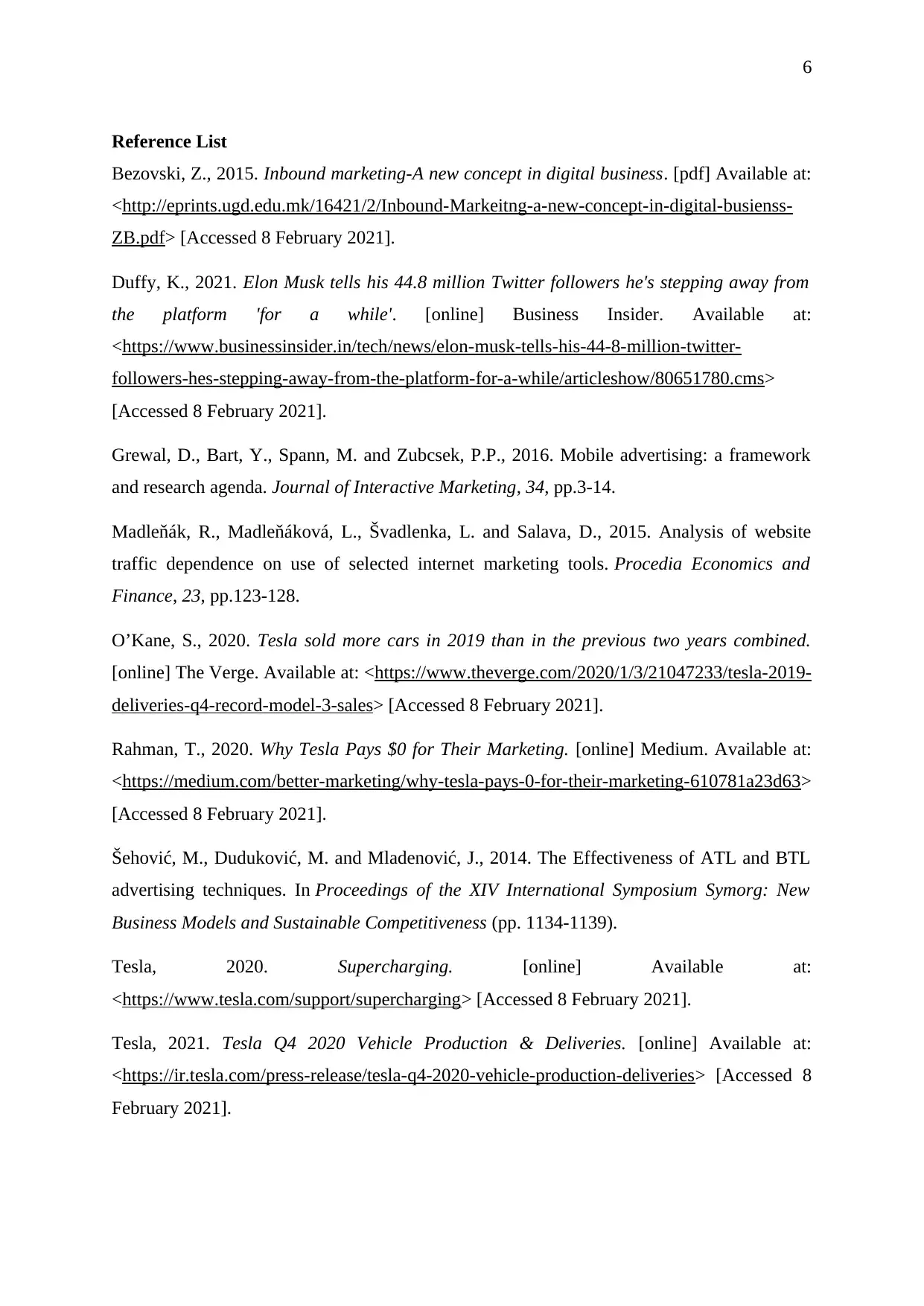
6
Reference List
Bezovski, Z., 2015. Inbound marketing-A new concept in digital business. [pdf] Available at:
<http://eprints.ugd.edu.mk/16421/2/Inbound-Markeitng-a-new-concept-in-digital-busienss-
ZB.pdf> [Accessed 8 February 2021].
Duffy, K., 2021. Elon Musk tells his 44.8 million Twitter followers he's stepping away from
the platform 'for a while'. [online] Business Insider. Available at:
<https://www.businessinsider.in/tech/news/elon-musk-tells-his-44-8-million-twitter-
followers-hes-stepping-away-from-the-platform-for-a-while/articleshow/80651780.cms>
[Accessed 8 February 2021].
Grewal, D., Bart, Y., Spann, M. and Zubcsek, P.P., 2016. Mobile advertising: a framework
and research agenda. Journal of Interactive Marketing, 34, pp.3-14.
Madleňák, R., Madleňáková, L., Švadlenka, L. and Salava, D., 2015. Analysis of website
traffic dependence on use of selected internet marketing tools. Procedia Economics and
Finance, 23, pp.123-128.
O’Kane, S., 2020. Tesla sold more cars in 2019 than in the previous two years combined.
[online] The Verge. Available at: <https://www.theverge.com/2020/1/3/21047233/tesla-2019-
deliveries-q4-record-model-3-sales> [Accessed 8 February 2021].
Rahman, T., 2020. Why Tesla Pays $0 for Their Marketing. [online] Medium. Available at:
<https://medium.com/better-marketing/why-tesla-pays-0-for-their-marketing-610781a23d63>
[Accessed 8 February 2021].
Šehović, M., Duduković, M. and Mladenović, J., 2014. The Effectiveness of ATL and BTL
advertising techniques. In Proceedings of the XIV International Symposium Symorg: New
Business Models and Sustainable Competitiveness (pp. 1134-1139).
Tesla, 2020. Supercharging. [online] Available at:
<https://www.tesla.com/support/supercharging> [Accessed 8 February 2021].
Tesla, 2021. Tesla Q4 2020 Vehicle Production & Deliveries. [online] Available at:
<https://ir.tesla.com/press-release/tesla-q4-2020-vehicle-production-deliveries> [Accessed 8
February 2021].
Reference List
Bezovski, Z., 2015. Inbound marketing-A new concept in digital business. [pdf] Available at:
<http://eprints.ugd.edu.mk/16421/2/Inbound-Markeitng-a-new-concept-in-digital-busienss-
ZB.pdf> [Accessed 8 February 2021].
Duffy, K., 2021. Elon Musk tells his 44.8 million Twitter followers he's stepping away from
the platform 'for a while'. [online] Business Insider. Available at:
<https://www.businessinsider.in/tech/news/elon-musk-tells-his-44-8-million-twitter-
followers-hes-stepping-away-from-the-platform-for-a-while/articleshow/80651780.cms>
[Accessed 8 February 2021].
Grewal, D., Bart, Y., Spann, M. and Zubcsek, P.P., 2016. Mobile advertising: a framework
and research agenda. Journal of Interactive Marketing, 34, pp.3-14.
Madleňák, R., Madleňáková, L., Švadlenka, L. and Salava, D., 2015. Analysis of website
traffic dependence on use of selected internet marketing tools. Procedia Economics and
Finance, 23, pp.123-128.
O’Kane, S., 2020. Tesla sold more cars in 2019 than in the previous two years combined.
[online] The Verge. Available at: <https://www.theverge.com/2020/1/3/21047233/tesla-2019-
deliveries-q4-record-model-3-sales> [Accessed 8 February 2021].
Rahman, T., 2020. Why Tesla Pays $0 for Their Marketing. [online] Medium. Available at:
<https://medium.com/better-marketing/why-tesla-pays-0-for-their-marketing-610781a23d63>
[Accessed 8 February 2021].
Šehović, M., Duduković, M. and Mladenović, J., 2014. The Effectiveness of ATL and BTL
advertising techniques. In Proceedings of the XIV International Symposium Symorg: New
Business Models and Sustainable Competitiveness (pp. 1134-1139).
Tesla, 2020. Supercharging. [online] Available at:
<https://www.tesla.com/support/supercharging> [Accessed 8 February 2021].
Tesla, 2021. Tesla Q4 2020 Vehicle Production & Deliveries. [online] Available at:
<https://ir.tesla.com/press-release/tesla-q4-2020-vehicle-production-deliveries> [Accessed 8
February 2021].
⊘ This is a preview!⊘
Do you want full access?
Subscribe today to unlock all pages.

Trusted by 1+ million students worldwide

7
Tselyutina, T.V. and Malkov, E.V., 2015. Event marketing in Russia: trends and
prospects. SWorldJournal, 21508(2), pp.76-82.
Tselyutina, T.V. and Malkov, E.V., 2015. Event marketing in Russia: trends and
prospects. SWorldJournal, 21508(2), pp.76-82.
1 out of 7
Related Documents
Your All-in-One AI-Powered Toolkit for Academic Success.
+13062052269
info@desklib.com
Available 24*7 on WhatsApp / Email
![[object Object]](/_next/static/media/star-bottom.7253800d.svg)
Unlock your academic potential
Copyright © 2020–2025 A2Z Services. All Rights Reserved. Developed and managed by ZUCOL.





